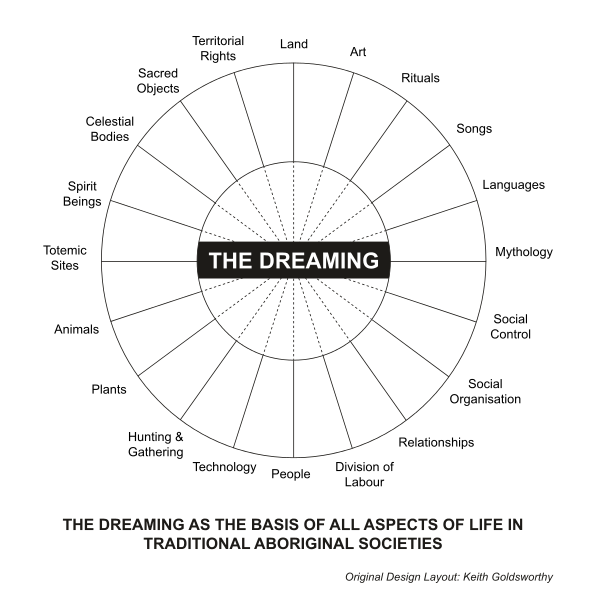Wikieducator.org/IND/week1/Dreaming Stories
The Dreaming
The Dreaming is an all-encompassing spiritual and knowledge system.
This topic introduces you to the Dreaming, or what the Arrernte people of the central desert region call altrjiranga ngambakala. The term ‘the Dreaming’ is an English word for an Indigenous concept. Different Aboriginal languages have different words to describe the phenomena. The term ‘The Dreaming’ is an anthropological translation of the Arrernte concept of altrjiranga ngambakala and is commonly used today to describe the rich, subtle and all encompassing spiritual belief system that forms the foundation of Aboriginal cultures and provides answers to the universal questions of humankind including, What is the purpose and meaning of life? How did we get here? How did the plants, animals, land and water come to be? Are we here for a reason? What is our destiny, as individuals, communities and as humankind as a whole?
The Dreaming should not be understood as something that happens while you sleep, or something that is imagined. The Dreaming is “many things in one. Among them, a kind of narrative of things that once happened; a kind of charter of things that still happen; and a kind of logos or principle of order” (Stanner, 1998, p. 228).
As you will learn from your studies in this module, unlike most western worldviews, Aboriginal people perceive no distinction between the secular and the sacred (meaning religion). Everything (not just people) is born and sustained by the spiritual essence of the Ancestors of the Dreaming and therefore all has purpose, meaning and destiny. It is from the Dreaming that come the laws for living and being. The Dreaming unites people to people, and people to land, plants, animals and the cosmos in a spiritual relationship which transcends the earthly realm to create a world in which ‘all life is in a sense sanctified’ (Edwards, 1998, p. 84).
Aboriginal Australia comprises over 270 language Nations and 500 dialect groups and while there are many underlying similarities between groups there is much diversity in culture. Thus, the legacies of the Dreaming Ancestors are as many and varied as there are differing regional environments and therefore while neighbouring Aboriginal groups may share common Dreaming Ancestors, Aboriginal groups separated by geographical distance often do not. This has created a rich and varied heritage of stories, art, ceremonies, songs and dance from across the continent explaining the creation of regional land and watercourse formations and the kinship and totemic relationships that form the foundations of Aboriginal societies.
The relationship between time and the Dreaming can often be a hard one for Western peoples to understand. As your readings for this week and the remainder of Module 1 demonstrate, the Dreaming is more than a creation story about how the world and its creatures were made long ago. The Dreaming is cyclical; it transcends linear time to be embedded in the now. As you undertake your readings for this week, try to reflect on the words of renowned anthropologist W.E.H. Stanner (1979, p. 28), cited above, who states:
- Clearly, The Dreaming is many things in one. Among them, a kind of narrative of things that once happened; a kind of charter of things that still happen; and a kind of logos or principle of order transcending everything significant for Aboriginal [people].
The diagram below is a visual representation of the all encompassing nature of the Dreaming.
Edwards, B. (1998). Living the Dreaming. In Bourke, C., Bourke, E., & Edwards, B. (Eds). Aboriginal Australia: An Introductory Reader in Aboriginal Studies (2nd ed., pp. 77-99). St Lucia: University of Queensland Press. Available through eReserve.
Clarke, P. (2003). Where the ancestors walked: Australia as an Aboriginal landscape (Chapter 2, pp. 15-29). Sydney: Allen & Unwin. Available as an eBook.
